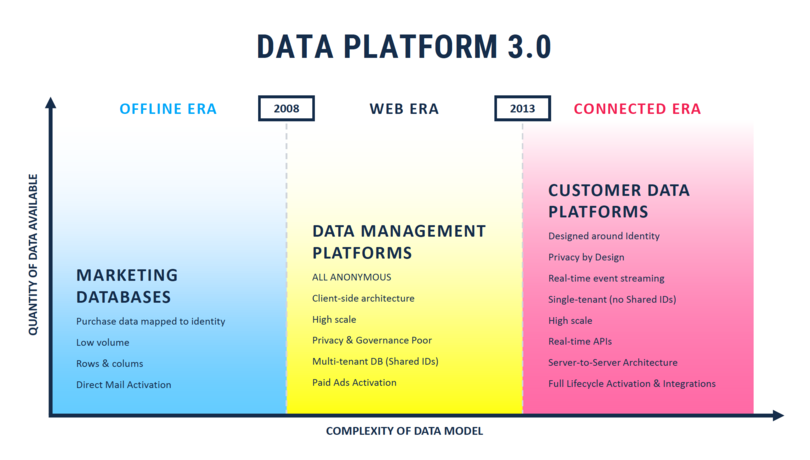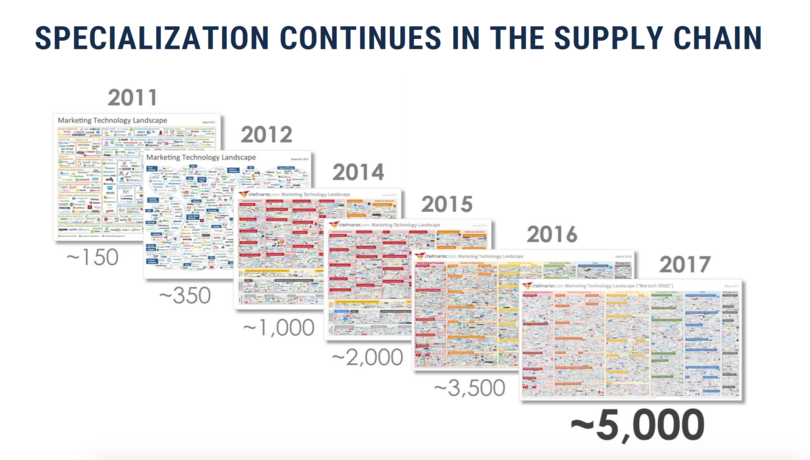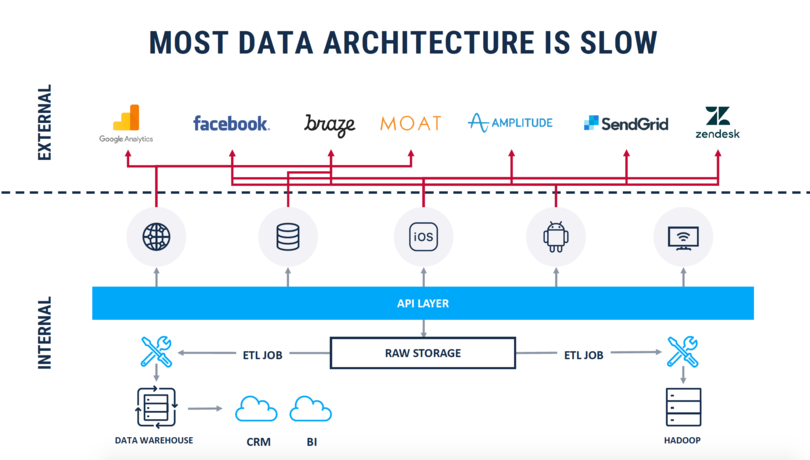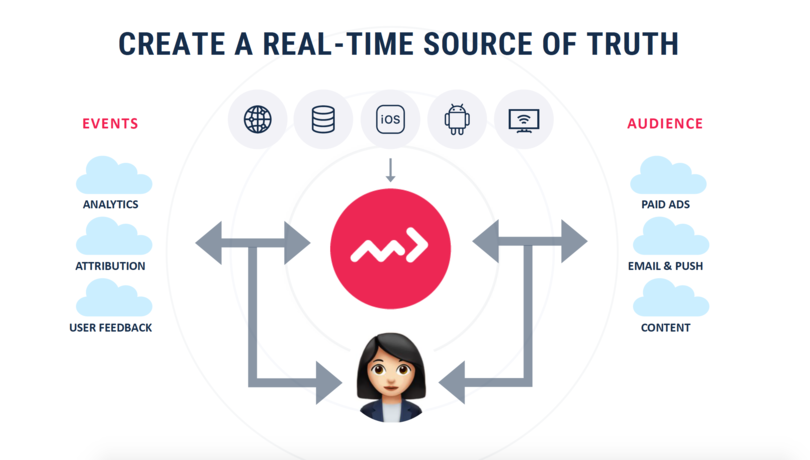Customer data management in the connected era
Customer data management in 2018 has to be agile, comprehensive, and secure, all in real time. Learn how a CDP can help you win in the Connected Era.

This blog is based on a presentation given by Michael Katz, co-founder and CEO of mParticle, at the Adexchanger Industry Preview 2018. Slides from this talk are available for download here.
Marketers are always looking for the next best thing to help them better understand their customer base. As technology has increasingly permeated into every aspect of daily life in the past decade, the breadth and depth of information available to marketers increased dramatically. Customers now produce huge quantities of data across channels and devices every day. Instead of facing a shortage of customer data, brands now face the problem of piecing together a current, coherent, and—most importantly—complete customer identity from the sea of data points created during every brand interaction across web, app, email, and beyond.
In fact, mParticle believes that the change from web-only to truly omnichannel customer experience is as big of a change as moving first from analog to digital.
In the Connected Era, marketers need to be able to track the customer journey in real time, at scale, across channels and devices, while complying with industry privacy standards. This is where a customer data platform (CDP) comes into play. But first, a primer on why marketing databases and data management platforms (DMPs), both long-tried and true data management systems, fall short in the Connected Era.
Data platform 3.0

Customer data management in the offline era
Before 2008, essentially the Offline Era, marketers relied heavily on marketing databases designed to handle the relatively low amount of customer data available to marketers. At this point in time, the extent to which brands were able to track their customers was largely dependent on mapping purchase data to customer identity. Companies at this time accessed simple records of customer data through their marketing database to power marketing campaigns. A keystone marketing campaign strategy used was direct mail activation, which involves sending a physical piece of marketing material to the customer addresses on record. This is still somewhat popular in certain retail markets across the United States, like that of clothing retailers, but is far from being the go-to it once was.
For a long time, marketing databases were able to keep up with the demands of marketing teams, but that all changed with the rise of the internet.
Web era
With the popularization of the internet, the number of ways brands could reach a single customer increased exponentially. From 2008 to 2017, the Web Era, marketers turned to DMPs to tailor advertising towards web users. DMPs serve as a hub, where data is collected at the site of each data silo, then brought back in for analysis and audience segmentation before being used to target customers across web platforms.
And, for a time, this was more than enough, but as the customer journey became more fragmented and mobile became a bigger part of daily life, DMPs’ shortcomings made it clear that something needed to change. Data collected through cookies is almost completely anonymous as DMPs are barred from storing personal identifying information (PII) and so are reduced to creating proxies for customers, limiting the degree of personalization and targeting possible. Simply put, when you put marketing to people head-to-head with marketing to proxies, marketing to people always wins.
But, as the old adage says, you can’t judge a fish by its ability to climb trees. DMPs were built to address the needs of marketers in the Web Era and continue to be a source of strategic data for marketers, but they simply weren’t built to address the complexities of a decentralized customer experience.
Welcome to the connected era
As of 2018, mobile has made its way to the center of the customer experience; 77% of the population owns at least one mobile device and the average adult spends just over four hours a day on their phone. More importantly, the immediacy of mobile has enforced higher expectations than ever for mobile experiences while lowering customers’ tolerance to anything but seamlessness.
Multithreaded customer journeys
Customers interact with brands across phones, tablets, web, email, social media, and beyond, a goldmine of customer insight is created in the form of data points. Brands need to be able to not only collect this data, they need to be able to collect it in real time, at a high scale, and be able to piece it into a cohesive narrative all while maintaining the standard of privacy demanded by customers.
Customers have come to expect a cohesive experience as they browse and begin a purchase on one device and complete their purchase on another, anything short of a cohesive experience is intolerable.
Identity changes everything
Brands need to think about identity as the foundation for unified marketing experiences. The shift from anonymity to identity provides marketers with stability; with identity, marketers are able to get a 360° view of the customer as they move through the identity continuum and are no longer at the mercy of cookies expiring or being deleted.
CDPs are designed around identity and are at the forefront of compliance with privacy regulations, including the soon-to-be-enforced GDPR, when it comes to collecting highly identifying customer data. This data is then able to be stored in either logically or physically separated identity space where it can be transformed, shared, and even deleted to maintain data control and transparency. In establishing customer identity, you are able to market directly to real people and create content that resonates and addresses their needs while meeting the standard of governance and control expected by customers and regulatory bodies.
Martech is more specialized than ever
If you look at the martech landscape that has emerged over the past few years, there is a strong trend towards specialization and companies are investing more of their budget in SaaS offerings. That’s both good and bad for marketers; good in that specialized technologies are better suited to address hyper-specific needs and collect better data from their respective spaces, but it’s also “bad” because it requires a bigger martech stack to gather all of the data necessary to create a continuous marketing experience.

A bigger stack wouldn’t be a problem were data identifiers standardized, but marketers are currently faced with a variety of naming systems. Fortunately, CDPs are able to transform and piece together data from different systems across a data stack to create a single view of the customer regardless of incompatibility between your systems.
Digital means NOW
The operating word in the Connected Era is connected. Mobile devices have made it so that we are not just constantly connected to each other, but also to our emails, social profiles, apps, and so on. Digital channels, especially when it comes to mobile, carry a sense of urgency because the mobile win is defined by how quickly marketers are able to react to customer actions and anticipate a customer’s needs. To minimize reaction time and take advantage of the information available to marketers through best-of-breed stacks, your data infrastructure needs to be agile. Just as data is generated in real time, marketers need to be able to rely on a real-time source of truth to reach customers at the right time.

In contrast to DMPs before them, CDPs use real-time APIs to collect real-time data across the entire customer lifecycle to create comprehensive customer profiles—no matter the source—that can then be forwarded to the services and platforms in your stack so you can take action.

Customer data management now needs to be able to connect to all of your data sources bidirectionally.
Why does customer data management matter?
Brands have to accept that customer data is the most valuable asset available to them in 2018, just as customers have started to demand increased control over how their personal data is collected and used. The wild west of customer data management is no more, with the most significant death knell being the enforcement of the GDPR for EU customers on May 25th of this year. Companies relying solely on outdated data management systems unable to meet GDPR standards will be forced to face fines equating up to 4% of global revenue or stop collecting data altogether in an effort to avoid punishment. It doesn’t have to be this way; CDPs are designed with privacy and identity at their core, allowing them to meet the new regulatory data standards without sacrificing the insight and actionability provided by customer data.
What this all boils down to is the customer experience; the moments that matter in the Connected Era are fleeting and so the margin for conversion is razor thin. In 2018, the answer to the marketer’s maxim of creating the right ad, to the right user, at the right time, is to get the right data, to the right system, in real time. Simply, you can’t expect to do that if the right system isn’t mapping the right identity, to the right system, all the time.
If you’d like to learn more about how mParticle can help your brand win in the Connected Era, feel free to reach out. Or, to learn more about CDPs, check out our in-depth CDP guide.




